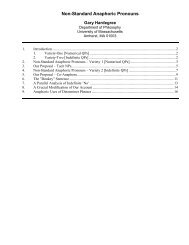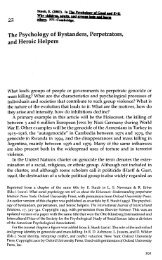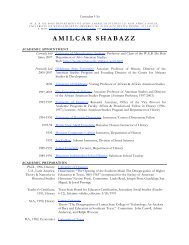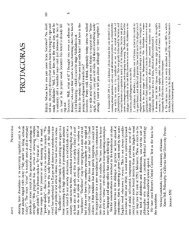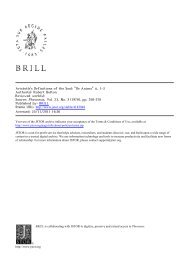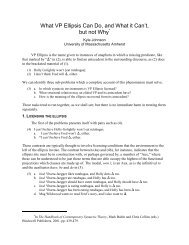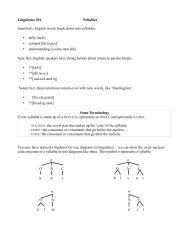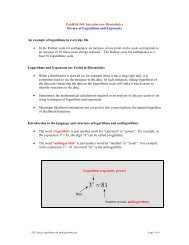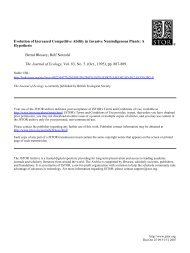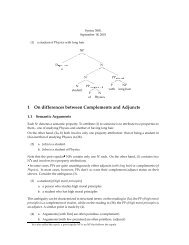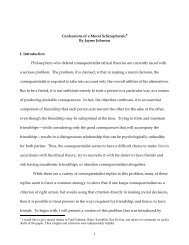Typology and variation in child consonant harmony - University of ...
Typology and variation in child consonant harmony - University of ...
Typology and variation in child consonant harmony - University of ...
You also want an ePaper? Increase the reach of your titles
YUMPU automatically turns print PDFs into web optimized ePapers that Google loves.
TYPOLOGY AND VARIATION IN CHILD CONSONANT HARMONY 17<br />
1;6 100% 100% 94% 100% 2;0 71% 0% 0% 0%<br />
1;7 100% 100% 97% 60% 2;1 67% 22% 2% 0%<br />
1;8 93% 50% 96% 17% 2;2 34% 0% 0% 0%<br />
1;9 100% 100% 97% 42% 2;3 6% 0% 0% 0%<br />
1;10 100% 25% 59% 12%<br />
To check prediction (73b), we can compare TOK <strong>and</strong> TIK, <strong>and</strong> KOT <strong>and</strong><br />
KIT words (no relevant data on progressive assimilation <strong>of</strong> labials).<br />
(75) Percent harmonized forms by month<br />
TOK TIK KOT KIT TOK TIK KOT KIT<br />
~1;5 96% 100% 100% 16% 1;11 100% 75% 0% 0%<br />
1;6 100% 100% 100% 22% 2;0 71% 0% 0% 0%<br />
1;7 100% 100% 100% 0% 2;1 67% 22% 0% 0%<br />
1;8 93% 50% 92% 15% 2;2 34% 0% 0% 0%<br />
1;9 100% 100% 45% 0% 2;3 6% 0% 0% 0%<br />
1;10 100% 25% 11% 0%<br />
Assimilation across front vowels ends earlier <strong>in</strong> both directions, <strong>and</strong> regressive<br />
assimilation across front vowels does last longer than progressive.<br />
Abstract<strong>in</strong>g from <strong>variation</strong>, we therefore see evidence for the follow<strong>in</strong>g<br />
rank<strong>in</strong>gs:<br />
(76) Developmental rank<strong>in</strong>gs <strong>of</strong> AGREE <strong>and</strong> NOGAP<br />
a. ~1;8: AGREE-L >> AGREE-R >> NOGAP<br />
bidirectional assimilation across back <strong>and</strong> front vowels<br />
b. 1;9~1;11: AGREE-L >> NOGAP >> AGREE-R<br />
regressive assimilation across back <strong>and</strong> front vowels<br />
progressive assimilation only across back vowels<br />
c. 2;0~: NOGAP >> AGREE-L >> AGREE-R<br />
assimilation only across back vowels<br />
6.3 Variation as unranked constra<strong>in</strong>ts<br />
Variational prediction <strong>of</strong> the typological account:<br />
(77) Velar assimilation across back vowels may occur with greater frequency<br />
than across front vowels, but never the reverse.<br />
This prediction is met by the <strong>variation</strong> that occurs <strong>in</strong> the pronunciation <strong>of</strong> the<br />
KIT words from the outset. S<strong>in</strong>ce TIK words are unaffected by <strong>variation</strong> at<br />
this po<strong>in</strong>t, the follow<strong>in</strong>g rank<strong>in</strong>g is posited to last until KIT words stop<br />
assimilat<strong>in</strong>g:<br />
(78) Posited rank<strong>in</strong>g through 1;9.2



